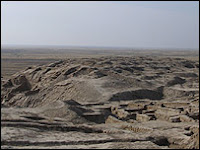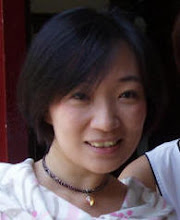'Mythical Roman cave' unearthed

Italian archaeologists say they have found the long-lost underground grotto where ancient Romans believed a female wolf suckled the city's twin founders.
義大利考古學家們表示,他們發現了一座失落已久的地下洞穴,古羅馬人深信母狼就是在這裡哺育了一對孿生子,也就是這座城市的創建者。
The cave believed to be the Lupercal was found near the ruins of Emperor Augustus' palace on the Palatine hill.
被認為是Lupercal的這座洞穴,被發現的地點是位於Palatine山丘上,一處由奧古斯都皇帝所建的宮殿廢墟附近。
The 8m (26ft) high cave decorated with shells, mosaics and marble was found during restoration work on the palace.
這座八公尺高的洞穴裡,有貝殼、馬賽克拼花圖案以及大理石做為裝飾,發現的時間正巧是在進行宮殿的修復工作。
According to mythology Romulus and Remus were nursed by a she-wolf after being left on the River Tiber's banks.
根據神話的記載,Romulus和Remus被遺棄在台伯河岸後,就由一匹母狼養育著。
The twin sons of the god Mars and priestess Rhea Silvia are said to have later founded Rome on the Palatine in 753 BC.
這對孿生兄弟正是戰神Mars與女祭司Rhea Silvia的兒子,傳說後來在西元前753年的時候,他們在Palatine山上建立了羅馬城。
The brothers ended up fighting over who should be in charge of the city, a power struggle which ended only after Romulus killed his brother.
這對兄弟為了這座城市的主宰權反目成仇,權力的鬥爭一直到Romulus殺了自己的兄弟之後才告終了。
In Roman times a popular festival called the Lupercalia was held annually on 15 February.
在羅馬時代,最受歡迎的節日是Lupercalia(牧神節),節慶舉行的時間是在每年的二月十五日。
Young nobles called Luperci, taking their name from the place of the wolf (lupa), ran from the Lupercal around the bounds of the Palatine in what is believed to have been a purification ritual.
因為母狼(lupa)所在的地方而被稱為Luperci的年輕貴族們,從Lupercal沿著Palatine的邊界飛奔,這被認為是一種淨化的儀式。
Naked, except for the skins of goats that had been sacrificed that day, they would strike women they met on the hands with strips of sacrificial goatskin to promote fertility.
赤著身體裹在山羊皮裡,這是由節日當天所獻祭的羊身上剝下的,他們會以手中撕成條狀獻祭的羊皮,拍打在沿途上遇到的女人,借此增加她們的生育力。
'Astonishing history'
Presenting the discovery, Italian Culture Minister Francesco Rutelli said archaeologists were "reasonably certain" that the newly unearthed cave could be the Lupercal.
描述這項發現的義大利文化部長Francesco Rutelli說,考古學家們相當確定這個最新發現的洞穴可能就是Lupercal。

"This could reasonably be the place bearing witness to the myth of Rome, one of the most well-known cities in the world - the legendary cave where the she-wolf suckled Romulus and Remus, saving them from death," he said.
"這裡相當可能是個足以證明羅馬神話的地方,是幾個世上最著名的城市之一 – 這個充滿傳奇的洞穴,母狼在這裡哺育Romulus及Remus,使他們免於死亡。"他說。
"Italy and Rome never cease to astonish the world with continual archaeological and artistic discoveries, and it is incredible to think that we have finally found a mythical site which, by our doing so, has become a real place."
"義大利和羅馬頻頻有考古和藝術的發現,從不停歇的讓世界感到驚訝,而這次真是難以至信的,我們終於找到了這個神話中的地方,因為我們的努力,它竟然成真了。"
The ancient cave was found 16m (52ft) underground in a previously unexplored area during restoration work on the palace of Augustus, the first Roman emperor.
.jpg)
這個古老的洞穴位在地底下16公尺處,是個之前未探測的地方,它的發現是在對第一位羅馬皇帝奧古斯都的宮殿進行重建工程時,才被發現。
Exploration of the cavity was hampered, however, by fears that it might collapse and damage the foundations of the surrounding ruins.
然而,由於該洞穴可能有崩塌以及損毀周遭廢墟地基之虞,探勘工作目前暫時受到了阻礙。
Archaeologists therefore used endoscopes and laser scanners to study it, ascertaining that the circular structure was 8m (26ft) high and 7.5m (24ft) in diameter.
考古學家因而使用內視鏡及雷射掃瞄技術來進行研究,確定這個圓型的建築有8公尺高、直徑約有7.5公尺。
A camera probe later sent into the cave revealed a ceiling covered in shells, mosaics and coloured marble, with a white eagle at the centre.
稍後,將探針射影機伸入洞穴後,展現了整個頂篷是佈滿了貝殼、馬賽克拼花圖案以及色彩繽紛的大理石,中央有一隻白色的老鷹。
"You can imagine our amazement - we almost screamed," said Professor Giorgio Croci, the head of the archaeological team working on the restoration of the Palatine, told reporters.
"你可以想像我們有多麼的驚訝 – 我們幾乎要尖叫了,"負責率領整個考古團隊進行Palatine修復工程的Giorgio Croci教授這麼告訴記者。
"It is clear that Augustus... wanted his residence to be built in a place which was sacred for the city of Rome," he added.
"毫無疑問的,奧古斯都希望他把自己的官邸建築在羅馬城最神聖的地方,"他補充說道。
The Palatine hill is covered in palaces and other ancient monuments, from the 8th Century BC remains of Rome's first buildings to a mediaeval fortress and Renaissance villas.
Palatine山丘佈滿了皇宮殿宇以及其它古代遺址,從西元前8世紀羅馬第一批建物遺存,一直到中世紀保壘及文藝復興時期的別墅。
After being closed for decades due to risk of collapse, parts of the hill will re-open to the public in February after a 12m-euro ($17.7m) restoration programme.
由於有崩塌之虞因而關閉了將近幾十年,進行了要價約一千兩百萬歐元的修復工程後,這座山丘的部份地區將再度在明年的二月對外開放。
 Story from BBC NEWS:
Story from BBC NEWS:
http://news.bbc.co.uk/go/pr/fr/-/2/hi/europe/7104330.stm
Published: 2007/11/20 20:20:39 GMT
© BBC MMVII

Italian archaeologists say they have found the long-lost underground grotto where ancient Romans believed a female wolf suckled the city's twin founders.
義大利考古學家們表示,他們發現了一座失落已久的地下洞穴,古羅馬人深信母狼就是在這裡哺育了一對孿生子,也就是這座城市的創建者。
The cave believed to be the Lupercal was found near the ruins of Emperor Augustus' palace on the Palatine hill.
被認為是Lupercal的這座洞穴,被發現的地點是位於Palatine山丘上,一處由奧古斯都皇帝所建的宮殿廢墟附近。
The 8m (26ft) high cave decorated with shells, mosaics and marble was found during restoration work on the palace.
這座八公尺高的洞穴裡,有貝殼、馬賽克拼花圖案以及大理石做為裝飾,發現的時間正巧是在進行宮殿的修復工作。
According to mythology Romulus and Remus were nursed by a she-wolf after being left on the River Tiber's banks.
根據神話的記載,Romulus和Remus被遺棄在台伯河岸後,就由一匹母狼養育著。
The twin sons of the god Mars and priestess Rhea Silvia are said to have later founded Rome on the Palatine in 753 BC.
這對孿生兄弟正是戰神Mars與女祭司Rhea Silvia的兒子,傳說後來在西元前753年的時候,他們在Palatine山上建立了羅馬城。
The brothers ended up fighting over who should be in charge of the city, a power struggle which ended only after Romulus killed his brother.
這對兄弟為了這座城市的主宰權反目成仇,權力的鬥爭一直到Romulus殺了自己的兄弟之後才告終了。
In Roman times a popular festival called the Lupercalia was held annually on 15 February.
在羅馬時代,最受歡迎的節日是Lupercalia(牧神節),節慶舉行的時間是在每年的二月十五日。
Young nobles called Luperci, taking their name from the place of the wolf (lupa), ran from the Lupercal around the bounds of the Palatine in what is believed to have been a purification ritual.
因為母狼(lupa)所在的地方而被稱為Luperci的年輕貴族們,從Lupercal沿著Palatine的邊界飛奔,這被認為是一種淨化的儀式。
Naked, except for the skins of goats that had been sacrificed that day, they would strike women they met on the hands with strips of sacrificial goatskin to promote fertility.
赤著身體裹在山羊皮裡,這是由節日當天所獻祭的羊身上剝下的,他們會以手中撕成條狀獻祭的羊皮,拍打在沿途上遇到的女人,借此增加她們的生育力。
'Astonishing history'
Presenting the discovery, Italian Culture Minister Francesco Rutelli said archaeologists were "reasonably certain" that the newly unearthed cave could be the Lupercal.
描述這項發現的義大利文化部長Francesco Rutelli說,考古學家們相當確定這個最新發現的洞穴可能就是Lupercal。

"This could reasonably be the place bearing witness to the myth of Rome, one of the most well-known cities in the world - the legendary cave where the she-wolf suckled Romulus and Remus, saving them from death," he said.
"這裡相當可能是個足以證明羅馬神話的地方,是幾個世上最著名的城市之一 – 這個充滿傳奇的洞穴,母狼在這裡哺育Romulus及Remus,使他們免於死亡。"他說。
"Italy and Rome never cease to astonish the world with continual archaeological and artistic discoveries, and it is incredible to think that we have finally found a mythical site which, by our doing so, has become a real place."
"義大利和羅馬頻頻有考古和藝術的發現,從不停歇的讓世界感到驚訝,而這次真是難以至信的,我們終於找到了這個神話中的地方,因為我們的努力,它竟然成真了。"
The ancient cave was found 16m (52ft) underground in a previously unexplored area during restoration work on the palace of Augustus, the first Roman emperor.
.jpg)
這個古老的洞穴位在地底下16公尺處,是個之前未探測的地方,它的發現是在對第一位羅馬皇帝奧古斯都的宮殿進行重建工程時,才被發現。
Exploration of the cavity was hampered, however, by fears that it might collapse and damage the foundations of the surrounding ruins.
然而,由於該洞穴可能有崩塌以及損毀周遭廢墟地基之虞,探勘工作目前暫時受到了阻礙。
Archaeologists therefore used endoscopes and laser scanners to study it, ascertaining that the circular structure was 8m (26ft) high and 7.5m (24ft) in diameter.
考古學家因而使用內視鏡及雷射掃瞄技術來進行研究,確定這個圓型的建築有8公尺高、直徑約有7.5公尺。
A camera probe later sent into the cave revealed a ceiling covered in shells, mosaics and coloured marble, with a white eagle at the centre.
稍後,將探針射影機伸入洞穴後,展現了整個頂篷是佈滿了貝殼、馬賽克拼花圖案以及色彩繽紛的大理石,中央有一隻白色的老鷹。
"You can imagine our amazement - we almost screamed," said Professor Giorgio Croci, the head of the archaeological team working on the restoration of the Palatine, told reporters.
"你可以想像我們有多麼的驚訝 – 我們幾乎要尖叫了,"負責率領整個考古團隊進行Palatine修復工程的Giorgio Croci教授這麼告訴記者。
"It is clear that Augustus... wanted his residence to be built in a place which was sacred for the city of Rome," he added.
"毫無疑問的,奧古斯都希望他把自己的官邸建築在羅馬城最神聖的地方,"他補充說道。
The Palatine hill is covered in palaces and other ancient monuments, from the 8th Century BC remains of Rome's first buildings to a mediaeval fortress and Renaissance villas.
Palatine山丘佈滿了皇宮殿宇以及其它古代遺址,從西元前8世紀羅馬第一批建物遺存,一直到中世紀保壘及文藝復興時期的別墅。
After being closed for decades due to risk of collapse, parts of the hill will re-open to the public in February after a 12m-euro ($17.7m) restoration programme.
由於有崩塌之虞因而關閉了將近幾十年,進行了要價約一千兩百萬歐元的修復工程後,這座山丘的部份地區將再度在明年的二月對外開放。
 Story from BBC NEWS:
Story from BBC NEWS:http://news.bbc.co.uk/go/pr/fr/-/2/hi/europe/7104330.stm
Published: 2007/11/20 20:20:39 GMT
© BBC MMVII

















